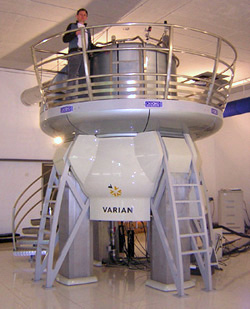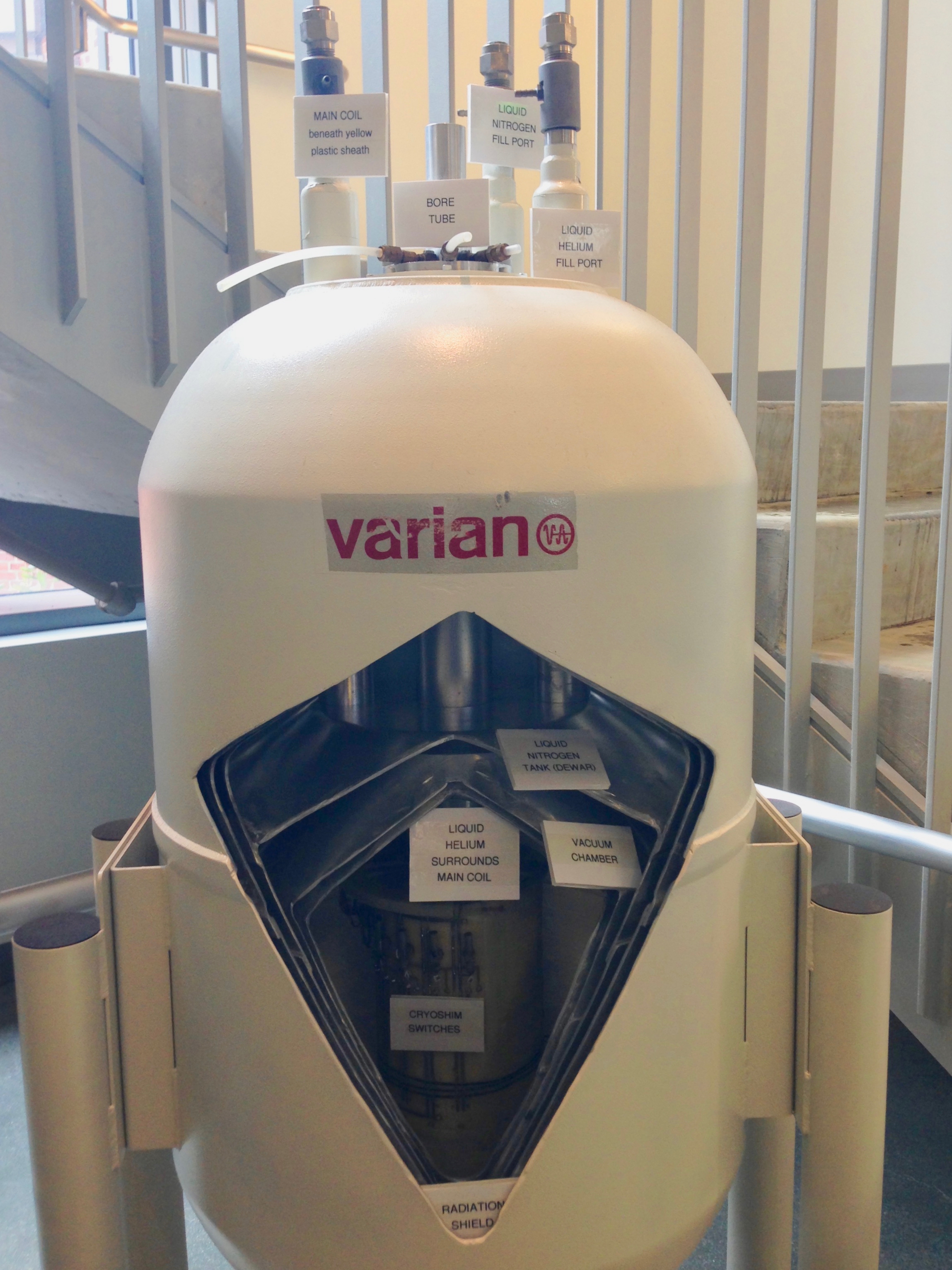|
Ernst Angle
In nuclear magnetic resonance spectroscopy and magnetic resonance imaging, the Ernst angle is the flip angle (a.k.a. "tip" or "nutation" angle) for excitation of a particular spin that gives the maximal signal intensity in the least amount of time when signal averaging over many transients. In other words, the highest signal-to-noise ratio can be achieved in a given amount of time. This relationship was described by Richard R. Ernst, winner of the 1991 Nobel Prize in Chemistry. Consider a single pulse sequence consisting of (1) an excitation pulse with flip angle \theta_E, (2) the recording of the time domain signal (Free induction decay In Fourier transform nuclear magnetic resonance spectroscopy, free induction decay (FID) is the observable NMR signal generated by non-equilibrium nuclear spin magnetization precessing about the magnetic field (conventionally along z). This non-e ..., FID) for a duration known as acquisition time a_t, and (3) a delay until the next excitation p ... [...More Info...] [...Related Items...] OR: [Wikipedia] [Google] [Baidu] |
Nuclear Magnetic Resonance Spectroscopy
Nuclear magnetic resonance spectroscopy, most commonly known as NMR spectroscopy or magnetic resonance spectroscopy (MRS), is a spectroscopic technique to observe local magnetic fields around atomic nuclei. The sample is placed in a magnetic field and the NMR signal is produced by excitation of the nuclei sample with radio waves into nuclear magnetic resonance, which is detected with sensitive radio receivers. The intramolecular magnetic field around an atom in a molecule changes the resonance frequency, thus giving access to details of the electronic structure of a molecule and its individual functional groups. As the fields are unique or highly characteristic to individual compounds, in modern organic chemistry practice, NMR spectroscopy is the definitive method to identify monomolecular organic compounds. The principle of NMR usually involves three sequential steps: # The alignment (polarization) of the magnetic nuclear spins in an applied, constant magnetic field B0. # The p ... [...More Info...] [...Related Items...] OR: [Wikipedia] [Google] [Baidu] |
Magnetic Resonance Imaging
Magnetic resonance imaging (MRI) is a medical imaging technique used in radiology to form pictures of the anatomy and the physiological processes inside the body. MRI scanners use strong magnetic fields, magnetic field gradients, and radio waves to generate images of the organs in the body. MRI does not involve X-rays or the use of ionizing radiation, which distinguishes it from computed tomography (CT) and positron emission tomography (PET) scans. MRI is a medical application of nuclear magnetic resonance (NMR) which can also be used for imaging in other NMR applications, such as NMR spectroscopy. MRI is widely used in hospitals and clinics for medical diagnosis, staging and follow-up of disease. Compared to CT, MRI provides better contrast in images of soft tissues, e.g. in the brain or abdomen. However, it may be perceived as less comfortable by patients, due to the usually longer and louder measurements with the subject in a long, confining tube, although "open ... [...More Info...] [...Related Items...] OR: [Wikipedia] [Google] [Baidu] |
Flip Angle
The flip angle is the rotation of the net magnetization vector by a radiofrequency pulse relative to the main magnetic field. To improve the signal when Magnetic Resonance imaging, the flip angle needs to be chosen using the Ernst angle In nuclear magnetic resonance spectroscopy and magnetic resonance imaging, the Ernst angle is the flip angle (a.k.a. "tip" or "nutation" angle) for excitation of a particular spin that gives the maximal signal intensity in the least amount of time .... Magnetic resonance imaging {{electromagnetism-stub ... [...More Info...] [...Related Items...] OR: [Wikipedia] [Google] [Baidu] |
Richard R
Richard is a male given name. It originates, via Old French, from Old Frankish and is a compound of the words descending from Proto-Germanic ''*rīk-'' 'ruler, leader, king' and ''*hardu-'' 'strong, brave, hardy', and it therefore means 'strong in rule'. Nicknames include " Richie", "Dick", " Dickon", " Dickie", "Rich", " Rick", " Rico", " Ricky", and more. Richard is a common English, German and French male name. It's also used in many more languages, particularly Germanic, such as Norwegian, Danish, Swedish, Icelandic, and Dutch, as well as other languages including Irish, Scottish, Welsh and Finnish. Richard is cognate with variants of the name in other European languages, such as the Swedish "Rickard", the Catalan "Ricard" and the Italian "Riccardo", among others (see comprehensive variant list below). People named Richard Multiple people with the same name * Richard Andersen (other) * Richard Anderson (other) * Richard Cartwright (disambiguati ... [...More Info...] [...Related Items...] OR: [Wikipedia] [Google] [Baidu] |
Free Induction Decay
In Fourier transform nuclear magnetic resonance spectroscopy, free induction decay (FID) is the observable NMR signal generated by non-equilibrium nuclear spin magnetization precessing about the magnetic field (conventionally along z). This non-equilibrium magnetization can be created generally by applying a pulse of radio-frequency close to the Larmor frequency of the nuclear spins. If the magnetization vector has a non-zero component in the xy plane, then the precessing magnetisation will induce a corresponding oscillating voltage in a detection coil surrounding the sample. This time-domain signal (a sinusoid) is typically digitised and then Fourier transformed in order to obtain a frequency spectrum of the NMR signal i.e. the NMR spectrum. The duration of the NMR signal is ultimately limited by T2 relaxation, but mutual interference of the different NMR frequencies present also causes the signal to be damped more quickly. When NMR frequencies are well-resolved, as is t ... [...More Info...] [...Related Items...] OR: [Wikipedia] [Google] [Baidu] |
T1 Relaxation
T1, T01, T.1 or T-1 may refer to: Biology * The first of the thoracic vertebrae in the vertebral column * Thoracic spinal nerve 1, a nerve emerging from the vertebrae * Cyclin T1, a human gene * GalNAc-T1, a human gene * Ribonuclease T1, a fungal endonuclease * TNM staging system, classification for a small cancer tumor Computing * Apple T1, a system on a chip used by Apple * T1 font, or cork encoding, a character encoding * T1, a component of the T-carrier system for telecommunication * UltraSPARC T1, a microprocessor Transportation Aircraft * Raytheon T-1 Jayhawk, a jet aircraft used by the US Air Force for advanced pilot training * Lockheed T2V SeaStar, a.k.a. T1 Seastar, a carrier-capable jet trainer in the US Navy * Fuji T-1, Japan's first jet-powered trainer aircraft * Sopwith Cuckoo, a British biplane torpedo bomber of 1918 Automobiles * Bentley T-series, Bentley Motors model in the UK * Caparo T1, a 2006 British sports car * CWS T-1, first serially-built car manufactur ... [...More Info...] [...Related Items...] OR: [Wikipedia] [Google] [Baidu] |
Nuclear Magnetic Resonance Spectroscopy
Nuclear magnetic resonance spectroscopy, most commonly known as NMR spectroscopy or magnetic resonance spectroscopy (MRS), is a spectroscopic technique to observe local magnetic fields around atomic nuclei. The sample is placed in a magnetic field and the NMR signal is produced by excitation of the nuclei sample with radio waves into nuclear magnetic resonance, which is detected with sensitive radio receivers. The intramolecular magnetic field around an atom in a molecule changes the resonance frequency, thus giving access to details of the electronic structure of a molecule and its individual functional groups. As the fields are unique or highly characteristic to individual compounds, in modern organic chemistry practice, NMR spectroscopy is the definitive method to identify monomolecular organic compounds. The principle of NMR usually involves three sequential steps: # The alignment (polarization) of the magnetic nuclear spins in an applied, constant magnetic field B0. # The p ... [...More Info...] [...Related Items...] OR: [Wikipedia] [Google] [Baidu] |

